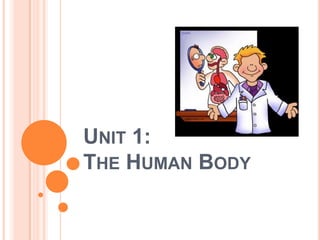
Du 1 the human body
- 1. Unit 1:The Human Body
- 2. Vocabulary skin epidermis dermis pores subcutaneous digestion Fromthetextbook: producer consumer foodchain predator prey food web
- 3. YourSkin Itcovers and protectseverythinginsideyourbody. Yourskinisthelargestorgan in yourbody. It: protectsourbodies, helpskeepourbodies at justtherighttemperature allowsustohavethesense of touch
- 5. FirstLayer: Epidermis Thelayeroutsideiscalledtheepidermis. The epidermis isthepart of yourskinyou can see.
- 6. The Dermis isUnderthe Epidermis The dermis tellsyouhowthingsfeelwhenyoutouchthem. Sweat comes up throughpores, tinyholes in theskinthatallowitto escape.
- 7. SubcutaneousFat Itisthethirdlayerof theskin. Itismade of fat and helpsyourbodystaywarm and absorb shocks, likeifyoufalldown. Thislayeriswhereyouwillfindthestart of hair, too.
- 10. YourBones Bonesgiveyourbodystructure, letyoumove in manyways, protectyourinternalorgans, and more. Youhave206 bones.
- 13. Muscles Youhave more than600 muscles. You have three different types of muscles in your body: smooth muscle, cardiac (say: kar-dee-ak) muscle, and skeletal (say:skel-uh-tul) muscle.
- 17. DigestiveSystem Digestionallowsyourbodytogetthenutrients and energyitneedsfromthefoodyoueat. Digestionbegins in yourmouth.
- 18. Parts of theDigestiveSystem ESOPHAGUS Theesophagusislike a stretchy pipe that’sabout 10 inches (25 centimeters)long. Itmovesfoodfromthe back of yourthroattoyourstomach.
- 19. STOMACH Yourstomachis a stretchysackshapedliketheletter J. It has threeimportantjobs: 1. tostorethefoodyouhaveeaten 2. to break downthefoodinto a liquidy mixture 3. toslowlyempythatliquidy mixture intothesmallintestine
- 20. The Small Intestine Thesmallintestineis a log tubethatisabout 3.5 to 5 centimetersaround, and 6.7 meterslong. Thesmallintestinebreaksdownthefood mixture even more so yourbody can absorballthevitamins, minerals, proteins, carbohydrates, and fats. Itgetshelpfromthreefriends: thepancreas, liver, and gallbladder.
- 21. Liver Theliverfiltersoutharmfulsubstancesorwastes, turningsome of thewasteinto more bile. Theliverstorescertainvitamins and a type of sugaryourbody uses forenergy.
- 22. TheLargeIntestine Itisabout 7 to 10 centimetersaround. Itisfatterthanthesmallintestine and itisalmostthelast stop onthedigestivetract.
- 23. TheRectum Itistheverylast stop onthedigestivetract. Thesolidwastestayshereuntilyou are readytogotothebathroom.
- 26. TheRespiratorySystem LUNGS Yourlungs are in yourchest. Youhavetwolungs. Thelungontheleftside of yourbodyis a bit smallerthanthelungontheright. They are protectedbyyourribcage, whichismade up of 12 sets of ribs. Lungs are pink and a bit squishy, like a sponge.
- 27. TheDiaphragm Beneaththelungsisthediaphragm. Itis a dome-shapedmusclethatworkswithyourlungstoallowyoutoinhale (breath in) and exhale (breathout) air.
- 28. Trachea At thebottom of thetrachea, orwindpipe, there are twolargetubes. Thesetubes are calledthemainstembronchi, and oneheadsleftintotheleftlung, whiletheotherheadsrightintotherightintotherightlung.
- 29. Thetiniesttubes are calledbronchioles, and there are about 30,000 of them in eachlung. At theend of eachbronchioleis a specialareathat leads intoclumps of teenytiny air sacscalledalveoli.
- 32. YourHeart and CirculatorySystem Yourheartisreally a muscle. Itislocated a littletotheleft of themiddle of yourchest, and itisaboutthesize of yourfist. Theheartsendsbloodaroundyourbody. Thebloodprovidesyourbodywiththeoxygen and nutrientsitneeds.
- 33. HowDoestheHeart Beat? Beforeeach beat, yourheartfillswithblood. Thenitsmusclecontractstosquirtthebloodalong. Whentheheartcontracts, itsqueezes. Yourheartdoesthisallday and allnight, allthe time.
- 34. HeartParts Theheartismade up of fourdifferentblood-filledareas, and each of theseareasiscalled a chamber. There are twochambersoneachside of theheart. Onechamberisonthe top (atria) and onechamberisonthebottom (ventricles).
- 35. Circulation Bloodmovesthroughmanytubescalledarteries and veins, whichtogether are calledbloodvessels. Thesebloodvessels are attachedtotheheart. Thebloodvesselsthatcarrybloodawayfromtheheart are calledarteries. Theonesthatcarryblood back totheheart are calledveins. Ittakesyourheartlessthan 60 secondstopumpbloodtoeverycell in yourbody.